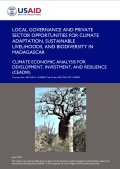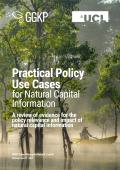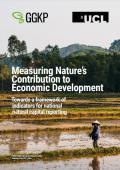
This report discusses the impact of USAID's activities, in collaboration with the Government of Madagascar, to support natural resource and biodiversity conservation and manage climate and non-climate stressors. It also discusses lessons learnt, challenges, opportunities, and recommendations for climate finance.

The Green Growth Knowledge Partnership (GGKP) Expert Group on Natural Capital has released the working paper, Practical Policy Use Cases for Natural Capital Information: A review of evidence for the policy relevance and impact of natural capital information. The paper outlines how natural capital approaches have been used in policymaking processes through a systematic review of 340 natural capital case studies.

The Green Growth Knowledge Partnership (GGKP) Expert Group on Natural Capital has released the working paper, Measuring Nature’s Contribution to Economic Development: Towards a framework of indicators for national natural capital reporting. The paper presents the Natural Capital Indicators Framework (NCIF) with a manageable set of natural capital indicators to assist policymakers in integrating natural capital assets, flows and benefits into their decision-making on economic development and green growth.

Climate-related litigation risk is the long-term risk that lawsuits targeting companies with high cumulated past emissions create liabilities, based on the company’s share of responsibility in the cost of global warming. It is not limited to direct emissions and likely to occur in countries where extra-territorial jurisdiction and class action lawsuits exist. The tort cost could include adaptation costs at the local level for states and cities (invested by anticipation), thus shortening the time horizon of risk from the years 2050-2100 to today. This concept note focuses on this type of risk.

The German government, through the German Federal Environment Agency, commissioned a consortium consisting of NewClimate Institute, Germanwatch, and the 2° Investing Initiative to explore criteria to measure the alignment of investment and financing with the 2°C limit.
